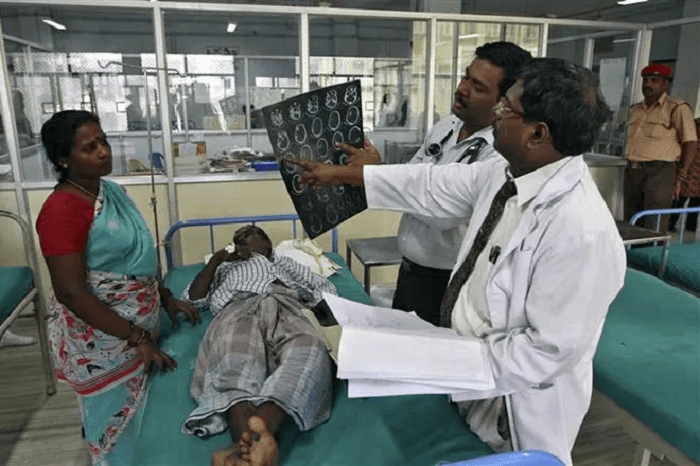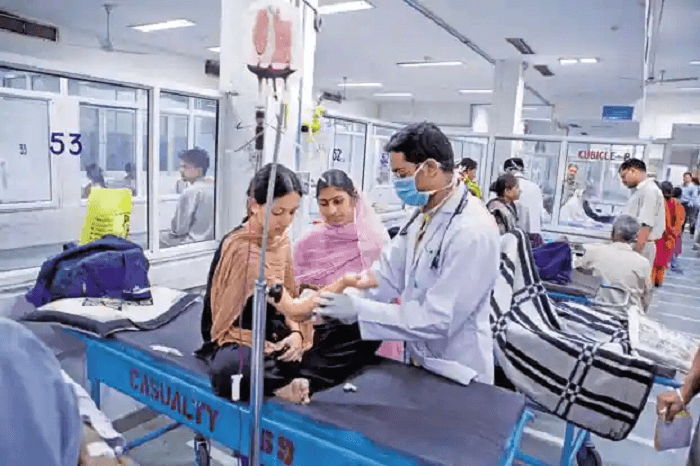Primary Health Care DefinitionPrimary health care (PHC) refers to the essential health care services that are accessible, affordable, and available to individuals and communities at the grassroots level. PHC was first defined in the Alma-Ata Declaration in 1978 as "health care based on practical, scientifically sound, and socially acceptable methods and technology made universally accessible to individuals and families in the community through full participation and at a cost that the community and country can afford." Furthermore, PHC is the bedrock of a country's health-care system, and it is a critical component of achieving universal health coverage (UHC). 
History of Primary Health CareThe concept of primary health care was introduced in the 1940s, but it wasn't until the 1970s that it gained traction as a model for providing essential health care services to underserved communities. The World Health Organization (WHO) and the United Nations Children's Fund (UNICEF) held the Alma-Ata Declaration in Alma-Ata, Kazakhstan, in 1978. The declaration called for "health for all" by the year 2000, emphasizing the significance of primary health care in achieving this goal. The declaration acknowledged the need for practical, scientifically sound, and socially acceptable methods and technology that could be made universally available through community participation and at a cost that the community and country could afford. Since the Alma-Ata Declaration, primary health care has been recognized as the foundation of a country's health care system and a critical component of achieving universal health coverage (UHC). UHC is defined as ensuring that all individuals and communities have access to quality health care services without experiencing financial hardship. UHC is a central component of the United Nations Sustainable Development Goals (SDGs), which aim to end poverty, protect the planet, and ensure that all people enjoy peace and prosperity. Components of Primary Health CarePrimary health care consists of several key components that provide essential health care services to individuals and communities at the grassroots level. These components include: Health Promotion: Health promotion involves educating individuals and communities on healthy lifestyle choices and behaviors to prevent disease and promote wellness. This component includes health education programs, community outreach, and health literacy initiatives. Disease Prevention: Disease prevention involves activities such as immunizations and screenings to detect and treat illnesses early before they become more severe. This component includes vaccination campaigns, disease surveillance systems, and screening programs for infectious diseases such as tuberculosis and HIV/AIDS. Diagnosis and Treatment of Common Illnesses and Injuries: Primary care providers diagnose and treat common illnesses and injuries at the primary care level, which includes clinics, health centers, and community-based health workers. This component includes primary care services such as acute care, chronic disease management, and mental health services. Management of Chronic Diseases: Management of chronic diseases such as diabetes, hypertension, and asthma are critical to ensuring that individuals can receive ongoing care and avoid complications. This component includes disease management programs, patient education, and support groups. Importance of Primary Health CarePrimary health care is essential for achieving universal health coverage and promoting health equity. The benefits of primary health care include: Cost-Effective and Efficient: Primary health care is cost-effective and efficient because it focuses on preventing and treating common illnesses and injuries at the primary care level, which can reduce the need for more expensive and specialized care. Improves Health Outcomes: Primary health care can improve health outcomes by promoting healthy behaviors and lifestyles, reducing the burden of disease, and ensuring timely and appropriate care for chronic conditions. Addresses Health Disparities: Primary health care can address health disparities by providing accessible and culturally appropriate care to marginalized and underserved populations. Challenges to Primary Health CareDespite the importance of primary health care, there are several challenges that can impact its effectiveness and accessibility. These challenges include: Inadequate Funding: Inadequate funding can limit the availability of essential health care services and resources needed to support primary care. Workforce Shortages: Workforce shortages, particularly in rural and remote areas, can limit the availability of health care providers, making it difficult for individuals and communities to access care. Approaches To Primary Health Care Sector
In addition to the challenges mentioned earlier, PHC also faces several other obstacles that can impact its effectiveness and accessibility. For example, cultural and social factors can play a significant role in the delivery and uptake of primary care services. Language barriers, stigma, and mistrust of healthcare providers can make it difficult for individuals to access care or to follow through with recommended treatment. Additionally, geographical and transportation barriers can limit access to primary care services, particularly in rural or remote areas. Another challenge facing PHC is the increasing burden of non-communicable diseases (NCDs), such as heart disease, cancer, and diabetes. These chronic conditions require ongoing management and care, which can place a significant strain on primary care services. However, many PHC systems were designed to provide episodic care for acute illnesses, rather than ongoing management of chronic conditions. As such, there is a need to reorient PHC services to better address the needs of individuals with chronic conditions, such as through the use of team-based care models and the integration of technology to support self-management. Despite these challenges, there are many promising approaches and innovations that are being implemented to strengthen PHC and improve health outcomes. One example is the use of community health workers (CHWs) to deliver primary care services in underserved areas. CHWs are trained members of the community who provide basic health services and education, and serve as a link between the community and the formal health system. By working closely with community members and providing care in a culturally appropriate manner, CHWs can help to improve access to care and promote healthy behaviors. Another promising approach is the use of technology to support the delivery of PHC services. Telemedicine, or the use of remote communication technologies to provide healthcare services, has the potential to improve access to care in rural or remote areas, as well as to support ongoing management of chronic conditions. Mobile health (mHealth) interventions, such as text messaging and mobile apps, can also be used to promote healthy behaviors and to provide education and support for individuals with chronic conditions. Future Directions for Primary Health CareThe importance of PHC in achieving UHC and promoting health equity is becoming more widely recognised. In its global strategy for health 2020-2025, the World Health Organization has identified strengthening PHC as a top priority. Increasing investment in primary care services, improving care quality, addressing workforce shortages, and leveraging technology to improve access and delivery of care are all key strategies for strengthening PHC. PHC is also critical to the advancement of the Sustainable Development Goals (SDGs), particularly SDG 3, which aims to ensure healthy lives and promote well-being for all people of all ages. Strengthening PHC can help achieve several SDG goals, such as lowering maternal and child mortality, preventing and treating noncommunicable diseases, and promoting mental health and well-being. In addition to the strategies mentioned earlier, there are several other ways to improve primary health care delivery. One important strategy is to promote community engagement and participation in health care decision-making. By involving communities in the design, delivery, and evaluation of health services, we can ensure that services are tailored to local needs and preferences. Community participation can also improve the quality of care by providing feedback on health services and identifying areas for improvement. Another important strategy is to strengthen health information systems to support the delivery of primary health care. Health information systems are critical for monitoring and evaluating health services, identifying areas for improvement, and supporting decision-making at all levels of the health system. Investing in health information systems can improve the quality of care by providing timely and accurate information on health outcomes, service utilization, and health system performance. Innovative technologies can also play a significant role in improving primary health care. Telemedicine, for example, can increase access to health services in remote and underserved areas by enabling patients to consult with health care providers remotely. Mobile health (mHealth) technologies can also be used to support health promotion, disease prevention, and health education, particularly in low-resource settings. These technologies can also facilitate communication and information sharing among health care providers, improving coordination of care and patient outcomes. Lastly, global partnerships and collaboration can support the delivery of primary health care by sharing knowledge and expertise, leveraging resources, and coordinating efforts to strengthen health systems. The Global Alliance for Vaccines and Immunization (GAVI), for example, has played a critical role in increasing access to vaccines in low-income countries. The World Health Organization (WHO) also provides technical assistance and guidance to countries to strengthen health systems and improve the delivery of primary health care services. ConclusionPrimary health care is a critical component of any health system, providing essential health services that are accessible, affordable, and available to individuals and communities at the grassroots level. While there are many challenges facing primary health care, there are also many opportunities for innovation and improvement. By investing in primary health care and strengthening the delivery of essential health services, we can improve health outcomes, reduce health disparities, and contribute to the achievement of universal health coverage and the Sustainable Development Goals. Through partnerships and collaboration, we can work together to ensure that every individual and community has access to quality health care services, regardless of their socioeconomic status, geographic location, or cultural background. Overall, primary health care is a crucial component of a country's health care system, providing essential health services that are accessible, affordable, and available to individuals and communities at the grassroots level. While there are challenges to delivering effective primary care, such as inadequate funding and workforce shortages, investing in and strengthening PHC can improve health outcomes, reduce health disparities, and contribute to achieving universal health coverage and the Sustainable Development Goals.
Next TopicPoint Definition
|
 For Videos Join Our Youtube Channel: Join Now
For Videos Join Our Youtube Channel: Join Now
Feedback
- Send your Feedback to [email protected]
Help Others, Please Share









